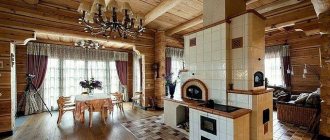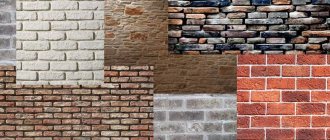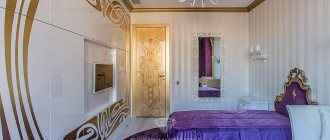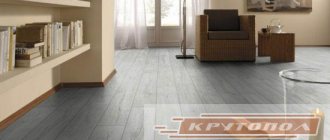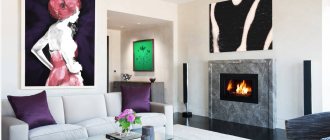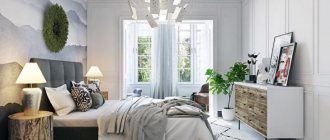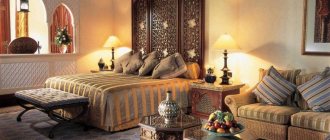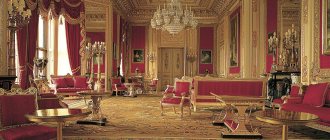Art Deco is a very popular, incredibly expressive, elegant, recognizable style that has long been loved by many modern designers. It always looks rich and elegant, giving pleasure to those contemplating this interior. Most often used to decorate hotels, expensive restaurants, halls where official receptions, weddings, and banquets are held. From the outside it seems that in such a room you can not only live and relax, but also make films and do photo shoots for memory. Read more about what Art Deco looks like in the interior of various rooms, how and where it originated, and its main features in the text of this article.
History of the style
The style originated at the beginning of the twentieth century in France, namely in Paris. By the 20s and 30s he had reached the peak of popularity. These were the post-war years of crisis, the Great Depression was gaining momentum, but by the 40s the style had already entered the international arena. It combined functional industrial with shades of African primitivism, the spirit of the Jazz Age with the rigor of neoclassicism, shiny metal with precious woods, and the color palette of Fauvism with black and white gradients.
Later, in some countries, Art Deco or Art Deco gave birth to the functionalism style, and at the same time the Art Nouveau style arose, embodying a new art. Art Deco had a noticeable influence on the architecture of buildings and interior design of the USSR during the Stalinist period - the 30-40s. At that time it was considered a “respectable style for the middle class”, and therefore was considered unacceptable for most Soviet people. Tourism and travel to exotic countries then became popular all over the world, and a fashion arose for various souvenirs and trophies brought from there.
Differences between Art Deco and Art Nouveau style
Art Deco arose immediately after the era of luxurious Art Nouveau, which is why these two movements, despite their obvious differences, are often confused. Let's try to figure out how to easily distinguish one from the other.
Interior in Art Nouveau style
| Peculiarities | Modern | Art Deco |
| Color spectrum | characterized by calm, muted shades | contrasts and bright accents |
| Shapes and lines | gravitates towards smooth curves | prefers strict geometry and clear lines |
| Materials | traditional wood species | exotic wood species |
| Invoices | matte surfaces | glossy surfaces |
All these features apply equally to both decoration and furniture with decor. As you can see, it is quite simple to understand what is in front of you: the design of an apartment in the Art Nouveau or Art Deco style. If you are sure that you need exactly the second one, then the “Interior Design 3D” program will help you transfer its luxury and elegance into an ordinary apartment.
Using the software, you can easily and quickly create an accurate layout of the premises, customize finishing materials and add sofas, cabinets, chairs, chandeliers to see how the finished version will look. Next, we will tell you what you should pay attention to when choosing materials for walls, floors and ceilings, as well as what interior items you will need to purchase.
Art Deco interior in the program "Interior Design 3D"
Distinctive features
The main features of art deco:
- a clear pattern in everything;
- bold “broken” geometry, including ethnic ornaments;
- asymmetry, streamlining, tortuosity of lines;
- an abundance of halftones with rare inclusions of overly bright colors;
- the most expensive materials;
- pretentious luxury, the highest chic of design;
- stylized images of animals, the latest technology;
- mosaic of wood, glass, stones, stained glass, many mirrors;
- crystal, expensive dishes, outlandish souvenirs from different countries;
- an abundance of varnish, glitter, glamour.
In modern times, real bone figurines, terracotta figurines from Africa or American Indian tribes are often replaced with crafts from local designers, which makes the design a little cheaper, without compromising the overall appearance.
Materials, surface finishing methods
The materials used are mostly modern and expensive:
- ivory, rhinoceros, deer horn;
- rare types of wood - mahogany, rosewood, sequoia, bog oak;
- reptile skin – snake, crocodile;
- various metals - aluminum, brass, steel, silver;
- natural, less often artificial stone - granite, marble, onyx, travertine, labradorite, slate;
- ceramics, expensive wallpaper;
- plasterboard, ceiling tiles;
- transparent, frosted, colored glass.
The ceiling is whitewashed, made of plasterboard, including a multi-level one, and decorated with gypsum and polyurethane stucco. Plastic ceiling rosettes, baseboards, corner elements, moldings and half-columns on the walls can be gilded or bronzed. The walls themselves are decorated with decorative plasters, silk wallpaper with geometric patterns or heraldic patterns, African patterns, and oriental hieroglyphs.
The floor is usually made of parquet, combining several types of wood, from which complex patterns are laid out - with central symmetry for the entire room or small, repeating ones. Less often, floors are decorated with stone, since it is very cold, and mirror design is suitable for both the floor and the ceiling, walls, and any furniture. Interior doors are preferably double-leaf wooden, paneled or with an insert of patterned glass, stained glass windows depicting fantastic scenes of ancient myths.
Color palette used
The following color combinations are often used:
- gold with black;
- white with golden brown;
- white-green with purple-black;
- chocolate with ivory color;
- beige with noble purple;
- purple with emerald;
- antique azure with terracotta;
- bistre with pale yellow;
- sand with bronze;
- gold with wine red;
- wisteria with graphite black;
- chestnut with quartz gray.
Golden, brown, and beige shades are almost always used as a base, complemented by accessories with bright splashes of red, blue, green, and purple.
Art Deco color scheme
Art Deco colors are bright and bold, with lots of contrast. Rich and deep yellow, red, green, blue and pink colors go well with chrome, silver and glossy black.
If you want something softer, add cream and beige shades. These colors contrast beautifully with the lacquered wood and shiny upholstery of the sofas and armchairs.
Advantages of Art Deco Design
Interior in the Art Deco style is quite expensive, but still many people choose it to decorate their apartments. Why?
- ✔ This is luxury, luxury and once again luxury. Who doesn’t want to feel like they’re in charge of life when they return home every day?
- ✔ An abundance of mirrors and light visually expands the room. A large number of windows with spectacular curtains are welcome here so that more sun from the street enters the room. A mandatory attribute is a variety of lamps. This will make even small apartments seem more spacious.
- ✔ Kaleidoscope of solutions. The style is surprisingly multifaceted, so you can decorate the interior of the apartment the way you like.
Windows and mirrors will make the room brighter
Keep in mind that Art Deco is not about creating coziness. The style even smacks of officialdom a little, so it is not suitable for rooms such as a child’s room. But it looks very impressive in the living room.
Art Deco has a lot of recognizable elements. Even if you don’t want to dedicate the entire interior to it, just a few touches can transform the room. Check out the layout below - wallpaper alone can set the tone! You can make your own options in the “Interior Design 3D” program.
Art Deco wallpaper transforms the interior
Art Deco is the style of celebrities and artists. It will give you inspiration, a positive attitude and joy of life, and your guests will invariably be delighted as soon as they step through the threshold. Create an island of chic and sophistication at home!
Furniture
All furniture has smooth lines and rounded corners. The materials used, in the vast majority of cases, are solid natural wood of valuable species, but sometimes even fiberboard, lined with veneer made from expensive wood, is allowed.
The main types of wood used for furniture in Art Deco interiors:
- rosewood;
- nut;
- oak;
- pink tree;
- maple;
- ash;
- palm tree.
Chromed, forged, inlaid, carved parts are also often used. Some pieces of furniture use glass, including frosted glass, stained glass, and ivory. Various types of leather are used to decorate upholstered furniture:
| traditional | veal, pork, sheep, goat, deer |
| exotic | snake, crocodile, fish, shark, elephant, zebra, lizard |
Many types of upholstery fabrics are used:
- dense jacquard;
- tapestry;
- velours;
- velvet;
- artificial leather;
- flock and others.
A lot of upholstered furniture is used for the art deco style - narrow sofas, couches, high beds, huge sofas, armchairs, soft chairs, poufs are present in all rooms. Furniture is often made to order, in single copies or limited editions. All furniture is made in one color, but individual elements can be made in a different color scheme to create several bright accents.
There is no need to give preference to overly massive pieces of furniture; if they are necessary, they should have separate elegant elements or decor - openwork carving, painting, inlay.
Features of the Art Deco style
Art Deco is a rather complex style that cannot be described in a nutshell, and yet you will always recognize it among dozens of others. And that's why:
- ✔ Strict geometry.
The style gravitates towards clear, expressive lines and regular figures. This is reflected both in the decoration and in the choice of interior details. The trapezoid shape is especially relevant. - ✔ Deliberate luxury.
Expensive furniture, paintings and other art objects. Every little detail indicates that wealthy people live here. - ✔ Mixing styles.
Art Deco is complex and heterogeneous - this is its peculiarity. Clear traces of Art Nouveau and Expressionism are visible here; modern technology and Egyptian symbolism are equally appropriate. - ✔ Stripes.
The alternation of contrasting colors (especially black and white) is certainly found in Art Deco. - ✔ Curved lines.
Since the style borrowed a lot from Cubism, it is often characterized by broken lines and curved geometry of objects. - ✔ Step transitions.
The interior uses steps, tiers, and podiums.
Mixing styles
Sunburst
is an important element of decor and finishing that can often be seen in interiors. It is believed that it was the motif of sun rays, that is, stripes diverging from the center to the edges, that became the reason for the “striations” of Art Deco.
Tiers in Art Deco
Textile design
An abundance of various textiles is usually present in the stylistic design of Art Deco. The fabrics chosen are plain, with zigzag, geometric patterns, colored stripes or checks; zebra, leopard, and snake prints are also suitable. Damask patterns, houndstooth patterns, and meanders are also popular.
The most commonly used fabrics are:
- velvet;
- cashmere;
- velveteen;
- tapestry;
- coarse woolen fabrics;
- silk.
The interior features luxurious carpets, heavy curtains, tapestries, cross-stitched paintings, pillows embroidered with gold patterns, and canopies with floral patterns framing the bed or dressing table. Soft blankets are made double-sided, from wool or faux fur.
Draperies on the walls also have a place, present at the head of beds or in the form of movable elements dividing a large space or studio apartment. Coffers of various sizes are present in the interiors of almost all rooms; they can be made in plain or variegated colors. Thick patterned curtains with a printed pattern are complemented by tulle with an abundance of flounces. The edges of the carpets are complemented by stripes of meanders or Chinese characters.
Accessories, decor
The decorative design is very diverse, most often the following items and details are present in abundance:
- figurines, animal figures;
- luxurious fans, candles;
- mirrors on any surfaces;
- forged gratings, including space zoning;
- paintings in carved frames - the larger the better;
- decorative ceramic and glassware;
- souvenir bottles with expensive alcohol;
- pearls, natural bone, turtle shells;
- dry bouquets, floral panels.
Among the paintings, in the descriptions of famous interiors, there are works by Klimt, Vasnetsov, Delorme, Serebryakova, Cassandre, Dupas and many others.
Among the artistic motifs of sculptures and paintings there are:
- geometric shapes - circles, squares, zigzags, polygons, ovals, black and white piano keys, steps;
- oriental motifs - ziggurats, pyramids, sphinxes, frescoes;
- plant and animal patterns and shapes - sakura branches, bonsai tree, leaves of exotic trees, fantastic animals, mythological characters;
- anthropomorphic subjects - Arabs, Indians, graceful figures of women.
In a too cramped room, you shouldn’t place too much decor; just focus on a few contrasting elements - the room will look cluttered.
Features of using color in the Art Deco style
Art Deco is dominated by neutral colors and their combinations:
- ✔ white,
- ✔ black,
- ✔ gray,
- ✔ beige,
- ✔ brown.
Art Deco colors
Metallic shades are common, with silver and gold being especially popular. Other, brighter colors are also sometimes used, but they are required primarily for decoration. Usually it is green, blue, burgundy, red in its most noble manifestations.
One of the iconic color schemes is a combination of black and white, piano keys. Many interiors are built precisely on this contrast, creating a truly stylish and respectable appearance for the room.
How to combine colors
The Art Deco style in the interior loves the play of contrasts. Light is combined with dark, forming an impeccably verified color base for the room. Bright colors are present mainly to create accents.
A popular solution is to use geometric patterns in contrasting shades: a light pattern on a black wall, as in the photo below.
Contrast of a light pattern with a black wall
Since Art Deco is a whole cocktail of styles, ethnic patterns are often used here. In interiors they like to use imitation animal skins: zebra, tiger or leopard.
Room interiors
This style is not widespread, but it is widely known everywhere. Any hints of asceticism or minimalism in the interior are alien to him.
The following are used in abundance here:
- carpets, curtains, all kinds of draperies;
- decorative fountains, podiums, arches;
- reproductions of paintings in the Cubist style, famous American graphic artists;
- sculptures made of ebony wood, ceramics;
- floor vases, palm trees in pots.
In the art deco style it is easy to combine objects that are difficult to fit into the framework of one style. There are always many elements involved, and the overall picture does not have to be conceptual.
It is unlikely that it will be possible to completely recreate the interior of a “palace” of the last century in a small apartment, but the use of individual elements and attributes of the style will make it possible to make at least a miniature likeness.
Bedroom
A light, tall chest of drawers, seemingly “bloated” on the sides, with curly handles on the drawer fronts looks good. Illumination on both sides of the bed above the bedside tables is carried out using a sophisticated sconce shape, with shades in the form of flowers that gently diffuse the light. Intricate interweaving patterns on the wallpaper will enliven the room, and a decorative or electric fireplace will create a feeling of warmth and comfort.
A bedroom looks ideal where one or two, maximum three groups of objects have the same pattern - the carpet is combined with curtains, ceiling tiles with wallpaper, pillows on the bed with upholstery and patterns on the parquet floor. A double bed with a patterned canopy and valance is in harmony with a sophisticated desk and dressing table, above which there is a round mirror framed in the shape of a sun. The dressing area is separated by a patterned screen.
If the wall opposite the head of the bed is decorated with an intricate labyrinth, which is often an attribute of the Art Deco style, then it will be pleasant to look at it while meditating before bed.
Living room
A huge leather sofa with a dome-shaped back will become the compositional center of an Art Deco interior. A medium-sized chest of drawers made of rosewood or palm wood, coated with a thick layer of varnish, a low “oriental” table, chairs or ottomans decorated with zebra or leopard prints will complement the interior. The middle of the ceiling will be decorated with a large crystal chandelier, and the corners will be decorated with floor lamps or sconces, made in the same luxurious style. On the floor in the very center of the room there will be a Japanese-style bamboo mat woven with gold threads or a fluffy carpet with folk ornaments.
A marble console that acts as a stand for a flat-screen TV would also be appropriate. In the most spacious rooms with high ceilings and good acoustics, they place a grand piano on a podium, and occasionally even a full-fledged drum set or a DJ console with all the accompanying paraphernalia.
The living room space may well look like a showroom, where many different objects are examined for hours, each time finding new details.
Children's
The furniture in the nursery, like other Art Deco rooms, does not have sharp corners. A warm, soft wool rug will allow children to play on the floor on long winter evenings. You should not overload this room with an abundance of fragile decor, especially if the children are small - safety comes first here. Stucco molding on the ceiling, a high-mounted lamp made of unbreakable glass, a canopy over the crib, many trunks for storing toys, a couple of pictures in carved frames - this is enough to clearly indicate the style.
It’s easy to decorate a room yourself, together with your child, by using a stencil to depict colored damask monograms and geometric shapes on the walls, lampshades, and window frames. The rising sun is often depicted above the headboard, in harmony with the same embroidery on the backs of soft chairs or sofa cushions.
The following shades are preferred here:
- pink, blue;
- gold, silver;
- violet, beige;
- light yellow, spring green;
- linen, bluish-gray.
A miniature dressing table is perfect for this style if the room belongs to a girl. A comfortable functional table with a suitable style is also made for the boy.
Kitchen
Light marble walls are often present in kitchens designed in this style. It looks most beautiful when the room has an insulated balcony, a spacious loggia or a bay window - some of the window glass is then decorated with colored stained glass, which allows even the most “pale” interior to sparkle with new colors.
A black and white checkerboard ceramic tile floor would be very appropriate here. It can be combined with a kitchen apron of the same color, sharply contrasting with a set that is light or overly bright. Curved worktops, a rounded bar counter with matching chairs will fit perfectly into the overall Art Deco style. The facades of the furniture must be glossy, the doors have engraved glass or stained glass, all household kitchen appliances are preferably built-in. The dining table has a luxurious tablecloth and the chairs around it are upholstered to match.
For a spacious kitchen, an island set is quite suitable, and space along the walls will be occupied by soft sofas and all kinds of decor.
Hallway
The walls of a long corridor are decorated with lamps stylized as oil lamps or candles, located on both sides, and a carpet is laid on the floor, as in a real palace. Plastic molding along the ceiling also wouldn't hurt.
A large mirror in a wooden or forged frame with gilding emphasizes the high cost of the interior from the threshold. Graphics will come in handy here: wallpaper with damask patterns, floor tiles or ottomans with the same pattern. The legs of the few hallway furnishings are often wrapped in fish skin. In the square hallway they hang a chandelier shaped like an inverted dome.
For a narrow corridor or cramped hall, choose the lightest possible wall design with a minimum of contrasts.
Bathroom
Walls decorated with frescoes a la Egypt will add uniqueness to this room, creating interesting accents. The same motifs are duplicated on towels and the curtain over the bathtub. Stone cladding, coupled with spot lighting, will add even more solidity to the interior. Monochrome porcelain tiles on the floor of a shared or separate bathroom, especially contrasting with the color of the walls, give a hint of the Renaissance, and an abundance of mirrors will make the room light and spacious. The golden mosaic designating individual areas of the room also looks great.
If the floor is made entirely of stone, it is advisable to equip it with special heating, otherwise it will be cold for bare feet to step on it even if there is a carpet.
Decorating an apartment in Art Deco style
Designing an apartment in the Art Deco style is very difficult. This is not Minimalism, where a suitable picture can be created with a couple of light strokes, and not Loft, in which colorful unfinished walls and pipes on the ceiling speak for themselves. Art Deco consists entirely of details that, like an ingenious mosaic, need to be put together to form an exquisite and complex pattern.
Art Deco is all about details!
The task is difficult, therefore, in order to transfer this style into their home, many turn to professional designers for help. However, it is quite possible to cope with it on your own. The main difficulty is creating a layout, based on which you will make repairs and buy furniture. But you don’t have to be a pro to do this; a convenient program is enough.
You will learn how to work in the “3D Interior Design” program in just a few minutes, and then you can experiment with the appearance of the apartment to your heart’s content. Search the Internet for ready-made ideas or come up with the details yourself, and then simply create several different layouts in the program to choose the best one. All you need to do is take 5 simple steps:
Step 1.
Download and install the program,
Step 2.
Draw a layout of the apartment, select windows and doors,
Layout of premises made in the program
Step 3.
Set up finishing materials,
Layout with Art Deco finish
Step 4.
Select and arrange furniture,
Ready-made room project in Art Deco style
Step 5.
Save and, if necessary, print the finished project.
Bedroom in Art Deco style
A bed must reign here. Luxurious, with a high inlaid headboard, carved legs and expensive linen. She should grab your attention and not let go.
Bedroom Art Deco
There must be mirrors in the bedroom - on the wall, in the dressing table, in the closet door. There can be a lot of them - this is only a plus. Mirrors add extra shine, the illusion of large open space, and also make the room brighter.
The color scheme of an Art Deco bedroom usually includes two main colors. These can be combinations of white with rich burgundy, gray with black or beige with deep chocolate. Sometimes there may be three colors.
Don't forget about the sparkling crystal chandelier, which will become a real highlight of the interior. Crystal can be replaced with original glass, which will also give a scattering of glare and shine.
A crystal chandelier will complement the Art Deco design
Living room in Art Deco style
This is the second room after the hallway where guests are allowed, and it is this room that should make the strongest impression. Choose expensive high-status furniture, rare and valuable accessories, hang eye-catching paintings.
Living room Art Deco
Typically, one dominant color is used to decorate the living room, and the rest of the interior items are selected in contrast to it.
To make the living room especially luxurious, objects and symbols of Ancient Egypt are often used. They will add chic and emphasize that the interior belongs to the aesthetics of the 30s.
Kitchen in Art Deco style
The main features of the popular Art Deco style do not bypass such an important room as the kitchen. Exclusive furniture and curtains, expressive decorative elements, contrasting colors are the necessary details.
Art Deco kitchen
Often the kitchen is decorated in black and white, although variations are possible. For example, white with dark brown or black with silver.
It is better to choose glossy tiles to give the room shine. Wooden parts are varnished, metal parts are polished.
